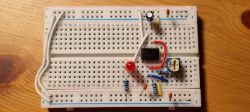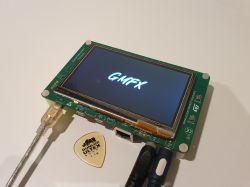
Hi
I`ve wanted to make my own digital multi-effect for electric guitar for a long time. I couldn`t get around to it for a long time due to various things, but it`s finally here. My project only concerns software for the ready-made STM32F746G-DISCO development board. It is a concept/prototype of a device rather than a ready-made device that can be taken on stage and played.
What is this?
For those who don`t know, a guitar effect is a device (or software) used to modify a guitar`s signal to obtain a characteristic sound. Such effects may be based solely on analog electronics, but they can also be achieved using digital signal processing, either on a microcontroller or in computer software.
How it`s working?
Below is a short video briefly showing how the device works. I add three effects there: overdrive, cab sim and reverb and then I play a short melody. An electric guitar is plugged directly into the multi-effects input and its output is connected to a regular portable speaker. Later, separate audio samples for each effect will appear in the description.
Equipment
I had no plans to build a dedicated hardware platform for this purpose, because I already had a development board with everything necessary, and I was more interested in signal processing algorithms. Therefore, as I mentioned earlier, the project works on the STM32F746G-DISCO board. From the user`s point of view, the audio line input and output as well as the graphic touch display are important here.
Software
It will be difficult for me (and I don`t want) to describe the code in detail here, so I will summarize it to the most important things. The project is written in C++17. The application code is separated from the hardware and RTOS using abstraction layers. We`ll see if I did it right when I need to move the code to something else
The source code is on mine github , a project created in Eclipse.
Effects
Currently, six popular guitar effects work: tremolo, echo/delay, chorus, reverb, overdrive and cab sim (speaker cabinet simulator). Effects can be added to the processing "chain" in any order from the menu. Audio signal processing is double-buffered and takes place in blocks, where the size of one block is 128 samples. The block size translates directly into the delay between input and output, which is approximately 6ms. Digital audio parameters are 24bit/48kHz.
In the following description of the effects, in a "pathological" way, I will summarize the basics of their operation (and for details, please refer to the literature provided at the end). The included audio samples contain a pure guitar signal at the beginning, and only in the second half the effect is active.
Tremolo
This is probably the simplest effect, which involves modulating the amplitude of the guitar signal using a low-frequency oscillator.
Sound modification controls:
- rate: oscillator frequency, range 1 - 20Hz
- depth: modulation intensity, range 0 – 0.5
- mode: modulation shape, sine/square
Echo
The main element of this effect is the delay line. As the name suggests, it is used to delay the input signal by a given amount of time, which can be adjusted. To obtain the effect of many repetitions (echo), the signal from its output is fed to the input, previously multiplied by a factor less than 1 so that the repetitions fade out. In addition to multiplication, a low-pass filter can be used here to suppress high repetition rates and obtain an effect similar to analog echo effects based on magnetic tape.
Sound modification controls:
- blur: blur repetitions (low-pass filter), range 2 – 8kHz
- time: delay time, range 0.05 – 1s
- feedback: repetition fading, range 0 – 1
- mode: selection of echo/delay mode
Chorus
It`s just a choir. The main mechanism of this effect is doubling the original sound source, then slightly shifting it in time (and possibly modulating this time) and finally summing it with the original. A delay line is also used here, but its delay time is modulated with a low-frequency oscillator.
Sound modification controls:
- depth: modulation intensity, range 0 – 1
- rate: modulation frequency, range 0.05 – 4Hz
- mix: mix of the original with the effect, range 0 – 1
- mode: selection of the effect type
Reverb
This is an effect that simulates the reverberation in a room, hall, etc. The task of the algorithm is to create a fairly large number of "reflections" of the original signal, circulate them, possibly modulate them, sustain them and then dampen them. A good-sounding reverb algorithm is difficult to develop and is usually computationally demanding due to its complexity. Here I used a certain well-known topology by J. Dattorro from the 1990s, simulating an analog plate reverb.
Sound modification controls:
- bandwidth: low-pass filter on the input, range 0 – 24kHz
- decay: reverb length, range 0 – 0.999
- damping: reflection suppression (DP filter), range 0 – 24kHz
- mode: effect mode without/with modulation
Overdrive
One of the most popular effects in rock and metal music. The main task of the algorithm is to change the shape of the signal in such a way as to "cut" or "flatten" the signal when it exceeds a certain value. In analog effects this is achieved, for example, by using diodes connected in anti-parallel (symmetrical clipping). In digital, however, a non-linear function is usually used, e.g.: y = tanh(kx)/tanh(k) where the argument x is the input signal and y is the output. Using such procedures introduces a number of harmonics into the signal, so it is necessary to remember to reduce the phenomenon of aliasing. Overdrive algorithms use oversampling and decimation for this purpose.
Sound modification controls:
- gain: signal gain, range 1 – 200
- tone: tone change (bass/treble), range 0 – 1
- mix: mix of the original with the effect, range 0 – 1
- mode: selection of soft/hard clipping type
Cab sim
This is a simulation of the sound of a guitar cabinet. It is usually "applied" directly after the overdrive, so that we do not hear the terrible clamor of the distorted signal in the headphones.
Sound modification controls:
- list with impulses of guitar columns
What can be added/improved
I have a list of a few things I plan to add in the future:
1) guitar tuner
2) saving/reading effect settings (presets).
3) designing unique effect panels (currently each panel looks almost the same)
4) Vocoder effect
5) footswitch support for changing effects
What are your suggestions?
Photos
Below are a few photos of the screen (sorry for their quality, but it`s hard for me to take a good photo of this LCD screen :/)
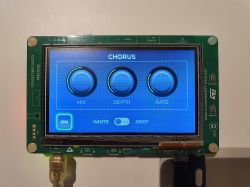
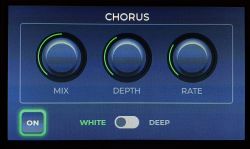

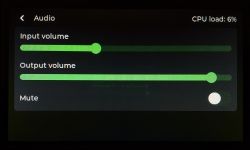
Sources
I found most of the theories about audio effects in the following sources:
1) Udo Zölzer, DAFX: Digital Audio Effects ,Second Edition
2) Will C. Pirkle, Designing Audio Effect Plugins in C++ ,Second Edition
3) J. Dattorro, Effect Design, Parts 1 – 3
and beyond that, all corners of the Internet.
If I forgot to write about something important - ask in the comments.
Cool? Ranking DIY




